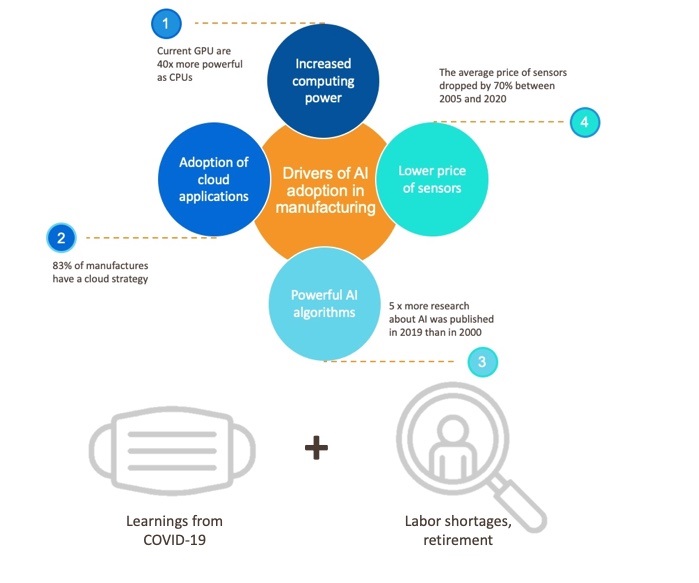I recently read a blog about the growing use of the cloud in manufacturing. The author described the shift he has seen in roughly these words: there was a seemingly overnight shift from ‘cloud computing will never happen in manufacturing’ to ‘it’s already here and we are doing it.’
From all I have been seeing over the last couple of years, we are approaching that watershed moment again, this time with AI. All the stars are aligned and the conditions are great for forward-looking manufacturers who have squeezed the last incremental improvements out of Six Sigma and are now ready to embrace the next big thing that will help them to manufacture faster, better, cheaper and more sustainably.
What are these “stars” that have aligned for AI in manufacturing?
There are four major advances in technology that are driving down cost and complexity and are making it more feasible for manufacturers to adopt AI-based algorithms for applications in quality inspection/control and predictive maintenance.
Here is a short overview of each.
Cloud computing – that quasi overnight shift I mentioned above did happen. Cloud applications, long frowned upon by manufacturers as too risky have been broadly adopted alongside traditional on-premise computing. The great value of the cloud is, that it makes unlimited computing power available in the time it takes to set up an account and enter your credit card information. This is a huge advantage because you don’t have to buy your own infrastructure which significantly reduces the cost of playing. Readily available, scalable computing power matters, e.g. for collecting and storing the vast amounts of data needed to train an algorithm.
Computing power – talking big data, we now have the computing power to actually analyze all that data. Data can now be stored in the cloud for weeks and months and then analyzed quickly using high-performance CPUs. Of special relevance for visual quality inspection are the powerful GPUs – developed at least in part for the gaming market – that can handle images at the speed needed for fast-moving consumer goods (cycle times of below 100 milliseconds).
Sensors – themselves are becoming cheaper and are reaching a point where they can literally be plastered all over the plant. Even high-end equipment like cameras doesn’t have to be expensive anymore, powerful AI algorithms do not require the same top-of-the-line ones that more finicky machine vision systems. One of our customers switched from their legacy $12K plus cameras to a model that costs less than $1000. This allows them to set up more QC stations along the production line and still save money plus reduce their inventory cost.
AI models – AI models have become increasingly more powerful and versatile over the last few years. Models for many different use cases – from the broad to the highly specialized – can be developed quickly based on a lot of new and exciting work coming out of academia.
Even five years ago, some of these crucial building blocks were still missing or too early in development. Now they are all coming together to make the adoption of AI on the shopfloor a realistic option for manufacturers.
What COVID taught us
In addition to technological advancements, the COVID 19 pandemic has exposed worrisome vulnerabilities in the manufacturing sector and the global supply chains. COVID highlighted the near-total dependency of the US and Europe on other countries, specifically China, for the manufacturing of goods and parts, whether it is PPE (80-90%), solar panels (80%), or toys (82%). Building new, more regional supply chains will help mitigate the risk of international supply chain disruptions and make regional economies more resilient. For manufacturing to be economical in places like Europe or the US AI adoption is necessary to increase efficiency, reduce cost and operate more sustainably.
Another important factor driving AI adoption is persistent labor shortages in manufacturing. While AI might still be considered a killer of desirable jobs by the general public, the reality in the manufacturing sector is actually quite the opposite. Manufacturers have struggled for years with hiring and retaining talent that is flocking in droves to more “sexy” industries like high tech. A 2021 report by the National Association of Manufacturers states, that 2.1 million manufacturing jobs could go unfilled by 2030 – in the US alone. Europe doesn’t fare better, the situation there has been described as “about to reach pre-crisis levels of employment in Q2 2021” with the situation being especially dire in Eastern Europe. Over the next five to ten years many manufacturers are faced with the formidable challenge of replacing their retiring workforce with new young hires and unclear plans on how to convince them not to go with the latest social media start-up instead.

With the four technology “stars” aligned and the need for the next industrial revolution driven by economic and demographic factors, the time is right for manufacturers to start adopting AI-based solutions.
Interested in learning more? Contact us here to discuss.

